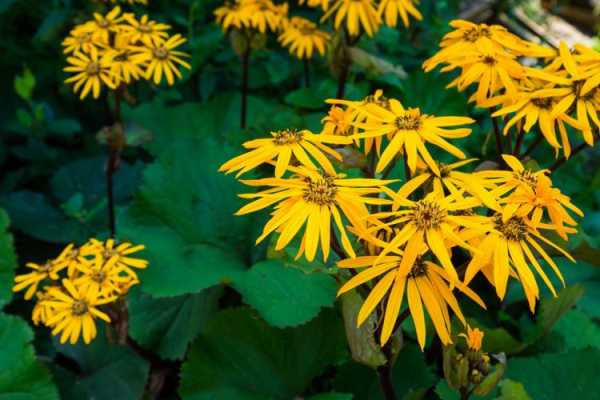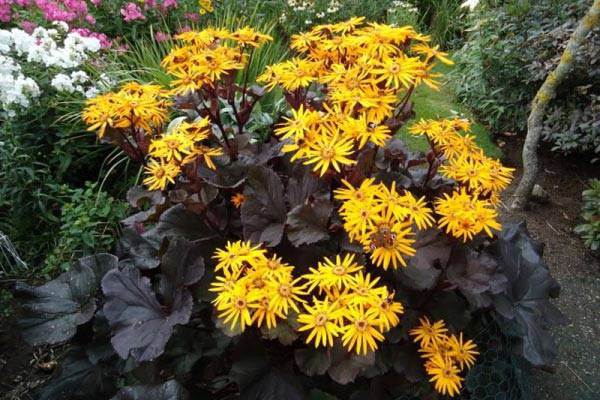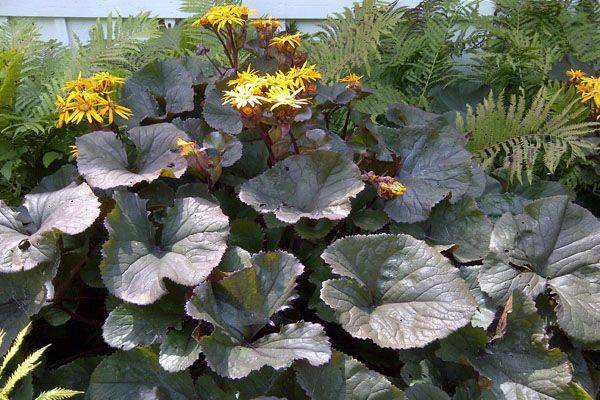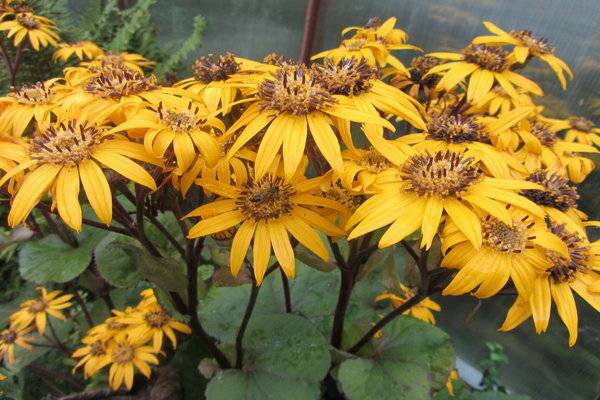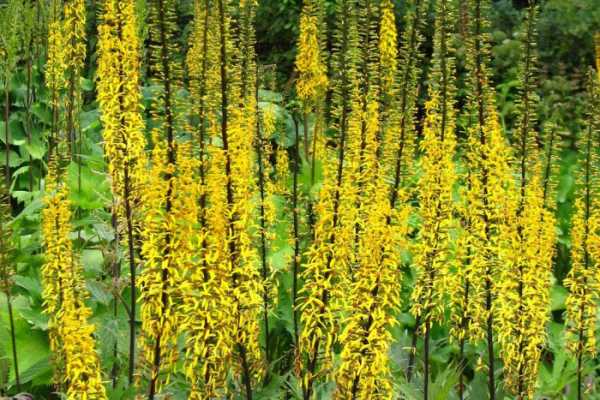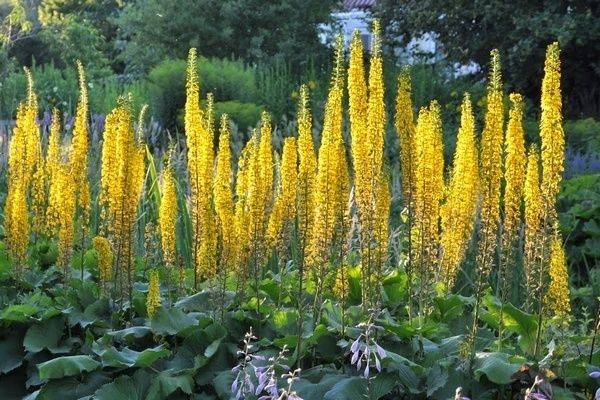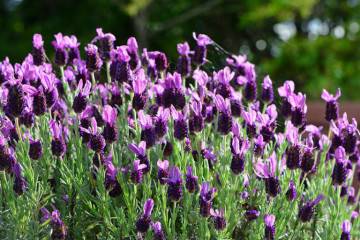Buzulnik - planting and care in the open field
Content:
Buzulnik (ligularia dentata) belongs to the popular perennials, representatives of the Astrov family. There are about 150 varieties of the plant, some of which are actively grown in personal plots. Experienced flower growers recommend that beginners start their first attempts at planting green spaces with this option.
Buzulniki: all varieties and types
It is impossible to describe all plant varieties in a short article. But if there is a desire to grow this flower at home, it will not hurt to know the most common ones.
Buzulnik toothed
Herbaceous perennial grows up to 1 m. The culture has kidney-shaped leaf plates emerging from the root rosette. Inflorescences are similar to an elongated panicle, consisting of small pale brownish and yellowish flowers. Flowering begins in late August. It tolerates the cold season well, but in severe frosts it needs insulation.
This type includes the following varieties:
- Brit Marie Crawford (marie crawford) - the variety requires maintenance in partial shade, grows up to 1 m. Deciduous plates are colored dark brown on one side, and purple on the other. In the reed variety of Buzulnik Brit Marie Crawford, the flowers are yellow or orange, in the tubular variety they are brownish.
- Buzulnik Othello (otello) - grows up to 1 m, has a glossy, dark green long foliage. The seamy side of the hardwood plates is painted in a deep dark red. The flowers of Buzulnik toothed Othello have a reddish-orange color, they are included in spike-shaped large inflorescences, with a diameter of up to 13 cm.
- Desdemona (desdemona) - differs in large panicle inflorescences with a yellow color. The foliage has a lilac brown color and jagged edges. Blossoming of desdemona busulum falls on the August days, ends in autumn.
- Dark Beauty is a spectacular representative 1 m tall. The foliage is large, glossy, heart-shaped, painted in a dark purple hue. In the buzulnik dark beauty, the inflorescences look like orange daisies. For the proper development of the culture, partial shade, a certain level of moisture and nutritious soil are required.
- Osiris Fantasy is a dwarf type that does not grow more than 50 cm. The foliage has an interesting color: the outside is dark green, the inside is dark red. Inflorescences consist of smallish yellow flowers, themselves large and long. Blossoming of Buzulnik Osiris Fantasy begins in mid-July and lasts until the first days of September.
- Osiris Evolution is a compact subspecies with large foliage of different colors: cream, mustard, pinkish and dark red. The flowers are similar to yellow daisies, located on high peduncles. Flowering begins in mid-summer and begins in the first weeks of September.
- Pandora (pandora) is a flower with a height of 20 to 40 cm. It prefers to develop in partial shade, withstands frosts up to 29 degrees. Buzulnik Pandora has glossy foliage, dark purple color, chamomile flowers, yellow color. It dissolves in July.
Spike-shaped types of buzulnik
This group is highlighted because of the peculiarities of the inflorescences. The list includes:
- Przewalski - an unpretentious flower does not require complex care. It grows up to 1.5 m in height, differs in dark green foliage, similar to wedge, and spike-shaped inflorescences with a bright yellow tint. Blooms from late July to early October.
- Rocket - can grow up to 2 m. Long and lush inflorescences are formed by small yellowish flowers, shoots with a reddish-brown tint. The foliage of the variety has a heart-shaped shape and a jagged edge. In summer, the plates are green, with the onset of September days, the color changes to maroon.
- Siberian - refers to rhizome herbaceous perennials, with a height of 0.3-1.3 m. It has rosette and furrowed foliage, heart-shaped-elongated. The inflorescences of Siberian Buzulnik are similar to large brushes, with a yellowish tint and a pleasant smell.
- Little Rocket is a species of Buzulnik Narrow-headed (like the Raketa variety) with heart-shaped, bright green leaves with jagged edges. Its size does not exceed 0.9 m, inflorescences are yellow, paniculate or racemose type. Blooms in August, buds remain until the first frost.
Buzulnik with pyramidal inflorescences
A very attractive variety that combines the following varieties:
- Fisher - herbaceous shrub reaches 0.3-1.5 m in height. The bushes have a shortened root system with grooved shoots, cordate and lance-shaped foliage, 23 cm long and 28 cm wide. The top is round or sharp, racemose inflorescences have a yellow tint and increased splendor. Blooms towards the end of June.
- Vicha - grows up to 2 m, has dark green foliage with a length of 40 cm. Spike-shaped inflorescences are formed from many yellow baskets, the buds bloom from the beginning of August, last until mid-September. The variety is frost-resistant.
Planting site, soil
The best place for culture is considered to be the shaded areas on the personal plot. With constant exposure to direct sunlight on the bushes, they will begin to lose their decorative properties and quickly fade.
The soil for planting must meet certain requirements:
- be fortified with nutrients;
- loose enough;
- easy to retain moisture.
Violation of the rules specified in the description entails slowing down and stopping the development of culture. The best option is considered a personal plot with an artificial reservoir, near which flowers are planted.
Planting from seeds
Seed propagation is used in rare cases due to the complexity of the procedure. After planting in open ground, young individuals will give the first buds no earlier than 3-4 years later. To get a seed, during flowering, several inflorescences are left on the bushes and wait for them to fully ripen. Then it is collected and dried.
Planting seedlings
Planting and care in the open field of a buzulnik begins with the selection of seed. It is planted in seedling boxes at a minimum depth, sprinkled with soil and sent to a room with diffused lighting and a constant temperature of 20-23 degrees.
It is not difficult to take care of young shoots: it is enough to observe the temperature regime and water the substrate in a timely manner.
Watering and loosening the soil
The culture loves enough moisture. Systematic watering is required throughout the summer, with special attention paid in hot and dry weather. To avoid wilting of foliage, the bushes are regularly sprayed. After the onset of September, watering is halved - otherwise, an excess will lead to decay of the root system.
Loosening of the soil is carried out after each watering - the culture requires a constant supply of fresh air.
Reproduction methods
Gardeners recommend propagating bushes:
- dividing the mother bush;
- planting seed material and subsequent transplantation of seedlings to a permanent habitat.
When dividing, shrubs are chosen that have lived in one place for at least 5 years. The procedure follows the following algorithm:
- In early spring, before the start of the active growth phase, a part of the shrub is cut off with a shovel. Separated seedlings should have several fertile buds.
- After careful digging, the remaining void is covered with a nutritious substrate (a mixture of garden soil with humus).
- The mother bush is watered abundantly.
- The planting material is washed with plenty of water.
- Places with a cut are sprinkled with activated carbon powder.
- Seedlings are sent to holes, with a depth and width of 40 cm.
Top dressing and transplanting
Ligularia can live in one place for many years, but it needs to be transplanted every five years. By rejuvenating a culture is meant dividing and planting in a new place.
This condition is associated with the following factors:
- the rapid growth of young bushes;
- dense interlacing of the root system with each other;
- violation of the growth and development of culture due to overcrowding.
The problem is solved only by a transplant. It is possible to plant a crop only in early spring - during this period it adapts more easily to new conditions and takes root quickly. Before the development of buds, the flower spends energy on nutrition and habituation, and not the growth of the green part.
The first feeding is carried out during planting procedures. Organic and mineral fertilizers are added to the garden soil, later bushes are added to the prepared pits and the earth is slightly tamped.
Fertilizers are introduced in May-July, under each shrub - 1/2 bucket of humus. Top dressing is not carried out with serious temperature changes - otherwise the bushes will lose their decorative appearance.
Pruning buzulnik
It is carried out after the end of the flowering phase. If you want to propagate shrubs with seeds, they leave several inflorescences until the material is completely ripe. Pruning is necessary to redirect the supply of nutrients to foliage and shoots, and not to dried buds.
Pests and diseases
The culture is practically not affected by diseases and insect pests. There are several problems that can cause serious damage to culture:
- Slugs - parasites feed on young leaves and stems. To get rid of their presence, sprinkle the area with walnut shells or superphosphate.
- Powdery mildew - in the fight against infection, spraying with soapy water or 1% colloidal sulfur is used.
Small numbers of slugs or snails can be removed mechanically. The rest of the time, special means are used: Thunderstorm, Snails and Meta.
Flowering period and care
The buds appear in late July, bloom in September.Some varieties decorate their gardens with flowers in August-September. The size, shape of the inflorescence depends on the type of culture:
- bright yellow long panicles of inflorescences;
- yellow-orange, reminiscent of chamomile.
During mass flowering, the buzulnik has a light and pleasant aroma.
Preparation for wintering
After the arrival of the first frost, the aboveground part of the bushes is trimmed. Next, you need to mulch the area where the culture is planted. Severe frosts, lack of snow in winter can cause the death of bushes.
Growing in cold regions requires special shelter for the shrubs for the winter. Pine or spruce branches, sawdust and leaves are used as a covering material.
Use in landscape design
Designers like to combine buzulnik with individual cultures, more often they use:
- hosts;
- snake highlander;
- soft cuff;
- primroses;
- tulips;
- basilist;
- meadowsweet;
- lungwort.
In landscape design, flowers are used:
- as a ground cover crop, helping to cover the ground with a uniform green carpet;
- to decorate the flower garden in the background;
- in the form of single or group plantings, highlighting the edges of artificial ponds, garden paths that adorn the facade of the house;
- to create a compositional center of the flower bed - planting is carried out in the center.
The flower is often used to cover problem areas on the site - fences, irregularities and abrupt transitions from hills to lowlands.
A hybrid buzulnik, planting and caring for which does not cause difficulties even for an inexperienced florist - a beautiful, unpretentious plant. Compliance with the rules of watering, feeding, loosening and pruning helps to get the perfect appearance of the backyard - due to the rare beauty of perennial bushes.
